France Bordeaux
The President of the Hong Kong
and China Sommeliers Association in Bordeaux
 Graduate of the University of South Australia, Nelson Chow has over 30 years of management experience in the hospitality industry as well as extensive teaching experience in hotel management and wine appreciation. His expertise has won him a number of highly respected titles in the professional realm, such as Chevalier de la Gastronomie Française and Commandeur du Bontemps. He is an accredited lecturer for the Ecole du Vin de Bordeaux (CIVB*).
Graduate of the University of South Australia, Nelson Chow has over 30 years of management experience in the hospitality industry as well as extensive teaching experience in hotel management and wine appreciation. His expertise has won him a number of highly respected titles in the professional realm, such as Chevalier de la Gastronomie Française and Commandeur du Bontemps. He is an accredited lecturer for the Ecole du Vin de Bordeaux (CIVB*).
At present, he is the Chairman of the Hong Kong and China Sommelier Association and it's as such that SommelierS International invited him for a tasting week in Aquitaine.
Entertained at the Grand Hôtel de Bordeaux & Spa, Nelson Chow and his charming wife Angelle arrived on November 23rd of last year in the capital of the wine. From Saint-Emilion to Saint-Julien; from Margaux to Lalande-de-Pomerol; from Graves to Haut-Médoc; from Pessac-Léognan to Blaye through the Cognac and Bas-Armagnac regions, their agenda was busy but the meetings rich in discoveries and in conviviality.
*Conseil Interprofessionnel du Vin de Bordeaux
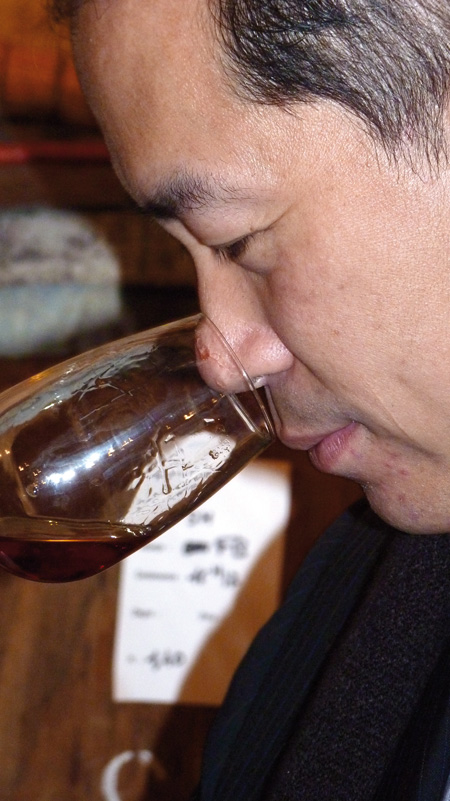
Thursday, November 24th
The weather was cold and foggy; a veil of mist was still laying over the Garonne when we left Bordeaux for Château Reynon, in Beyguey, in the appellation ‘Premières Côtes de Bordeaux’. Afterward we were expected for lunch at Château Lesparre, in Beychac and Caillau, then at Château Berthenon in ‘Premières Côtes de Blaye’, and finally at Château Cantinot, in Cars, for dinner.
Château Reynon Château Reynon is located in Béguey, near Cadillac, in the appellation Premières Côtes de Bordeaux, on a hillside of the right bank of the Garonne, facing due south. A part of the vineyard also occupies, on the nearby commune of Laroque, magnificent southeast-oriented slopes and the ancient limestone terrace of a small tributary of the Garonne, the Oeuille.
Jacques David, from an old viticulturist family of the nearby village, purchases the domain in 1958. His daughter, Florence, and his son-in-law, Denis Dubourdieu, succeed him in 1976. Thanks to their hard work, Château Reynon is today one of the most renown Premières Côtes de Bordeaux estate.
Denis Dubourdieu is considered as one of the top specialist in the winemaking process and the ageing of white wines. Œnology Professor at the University of Bordeaux and consultant to numerous wine producers in France and abroad, he simultaneously runs the family vineyards: Château Reynon, Château Doisy-Daëne, Clos Floridène, and Château Haura.
In his absence, his wife, Florence, greets us with a sweet smile, soon taken over by their son Jean-Jacques. Graduate in economics, the latter is responsible for distribution and promotion of family estates. He explains that in the early 80s, Château Reynon was best known for its dry white wines of Sauvignon. Moreover, its winery was, at that time, a laboratory of choice for Denis Dubourdieu, then a young Scientist at the University of Oenology who specializes in the wine making of dry white wines.
The techniques of skin contact and ageing on lees in barrel for Sauvignon Blanc and Sémillon were initially perfected in Reynon before being spread to the rest of the world.
The restructuring of the vineyard begins in 1988. The low-density vineyard of the late 50's is progressively re-planted with 5,500 vine plants per hectare. The12.8 hectares white vineyard is made up of 87% Sauvignon and 13% Sémillon. With a surface area of 20.5 ha, the red vineyard is composed of 81% Merlot, 6% Cabernet Sauvignon, and 13% Petit Verdot. Through this rehabilitation, the remarkable potential of Reynon's clayey soil for red wines is revealed.
As for all the other Dubourdieu family’s domains, traditional ploughing is performed on the soil of Château Reynon, and no weed-killer is used. Organic manures are made with vegetal-based composts. Bud removal, trellising and leaf removal are carefully done by hand.
Château Reynon produces a Premières Côtes de Bordeaux appellation red wine, a Bordeaux Sauvignon Blanc dry white wine as well as Bordeaux rosé wine. In some years, when the conditions are particularly well suited for the onset of noble rot, Reynon links back with an old tradition of the Garonne right bank slopes—devoted in the past to the production of great sweet wines—by producing an astonishing Cadillac dominated by Sauvignon.
The estate have also been producing since 2004 a red wine 100% Merlot aged in stainless steel tanks and bottled during the summer that follows grape harvesting. It’s labelled “Double D”. The second label red and white wines are commercialized under the name “Clos de Reynon”.
But Jean-Jacques Dubourdieu is also, within the family, the one who supervises the vinification of Barsac wines. Giving in to his passion, he makes us discover the Château Doisy-Daëne, Second Cru Classé in 1855. Replanted in its vast majority between the 50's and 60's, the vineyard is over 40 years old. It is currently 18.2 hectares wide. With a density of 7,000 plants per hectare,
it is planted with 86% Sémillon and 14% Sauvignon. It produces a great Sauternes wine along with distinguished and unusual dry white Bordeaux: Grand Vin Sec du Château Doisy-Daëne. During the great vintages, Doisy-Daëne produces a famous and rare cuvee of unequalled richness: L’Extravagant.
 Jean-Jacques Dubourdieu et Nelson Chow
Jean-Jacques Dubourdieu et Nelson Chow Château Reynon
33410 Beguey
Tél. +33 (0) 5 56 62 96 51
www.denisdubourdieu.fr Château LesparreGonet family had organized a wonderful tasting luncheon during which various wines from the family estates were served: Pessac Léognan Château Haut Bacalan 2009, Graves de Vayres Château Lesparre Grand Vin 2009, Graves de Vayres Château Lesparre Blanc 2010, Graves de Vayres Château Lesparre rouge 2007, Pessac Léognan Château Haut L’Evêque 2006, Pessac Léognan Château d'Eck 2007 and, of course, the sumptuous Champagne Michel Gonet Cuvee Prestige 2004. The audience was international; all the guests belonged to the wine world.
Situated halfway between Bordeaux and Libourne, the domain of Château Lesparre stretches over two appellations:
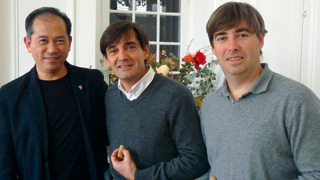 Nelson Chow, Charles-Henri et Frédéric Gonet
Nelson Chow, Charles-Henri et Frédéric Gonet Bordeaux Supérieur and Graves de Vayres spread on the municipalities of Vayres and Caillau (left bank of the Dordogne, facing Saint-Emilion).
This vast property has at the same time a historic past - it is a very ancient seigniorial domain - and a wine past because their wines are quoted for more than hundred fifty years. The Gonet Family, famous already for this Champagne, buy it in 1986. The challenge is to discover and tame new varieties while providing the Champagne methods in order to stand out and increase the quality of their product. There was therefore a real need to diversify, to expand the range and innovate continuously through the winemaking techniques.
For the two brothers, Frédéric and Charles-Henri Gonet, the constant increase of the wines and vineyards quality is a priority. First of all in 1990, we speak about an 'experimental property’; it is the passage in reasoned culture for the whole wine-producing exploitation. In 2006, the domain approaches the organic farming, then the biodynamic in 2010. The Château pursues this environmental approach for 20 years now and the results observed in the vineyard as well as on wines are impressive, much above expectations.
Château Lesparre covers today an area of about 200 hectares, among which 125 ha planted of vines. Varietals are traditional with however a preference for the Merlot which finds its entire dimension in this region. Harvest is partially done by hand and then vinified in temperature controlled stainless steel tanks, respecting both traditions and modern techniques.
The wines of Bordeaux Supérieur Appellation are matured in tank with micro-oxygenation to refine the tannins while developing the wine’s aromas.
The Graves de Vayres rest for long months in oak barrels, new for half, which provide structure and complexity.
The red wines are from Merlot (60 to 70% depending on the vintage), of Cabernet-Sauvignon (10 to 20%) and Cabernet-Franc (10 to 20%). The dried whites are from Sémillon (50 to 60%), Sauvignon (30 to 40%) and
Muscadelle (10%). Finally, the domain produces A Bordeaux rosé, pure Cabernet-Sauvignon.
For a few years, Gonet family reinvests the Asian market, allowing for continuing and increasing trade. The idea is to respond to the emergence of consumption of red wine promoted by the Chinese government.
In September 2010, some scenes of the movie “Love to the end”, by Chinese film director ZHANG YIBAI, were shot at Château Lesparre.
Château Lesparre
Moustey
33750 Beychac-et-Caillau
Tél. +33 (0) 5 57 24 51 23
www.gonet.fr Château Berthenon After some wanderings in the vineyards where we got lost because of the more and more dense fog, we are arrived, at nightfall, in this 32 hectares domain. Henri Ponz and his daughter Thérèse welcomed us with great kindness.
Paul Planteur (the grand-father) acquired in 1953 the Château Berthenon which was almost abandoned. He quickly passed on to his children Léa and Henri that rehabilitate it and made it prosper. Since 1999, the third generation, Thérèse and Thierry, took over, but Henri is still there. The oldest vines, those it has planted in his youth, now exceed 50 years.
Today, the Château Berthenon produces an average of 1,800 hl of wine per year, in Premières Côtes de Blaye and Bordeaux appellations. The vineyard is run in reasoned culture to respect at best the vines and allow them to express all the qualities of the soil, strongly influenced by the proximity of the Gironde estuary and the Ocean.
For the red wine, the Merlot (70%) brings its fruit, its roundness, and its delicate and racy tannins. The Cabernet Sauvignon (27%) gives to the wine its flowery then spicy character. The strength of its tannins guarantees the full blooming of the bouquet after few years of ageing.
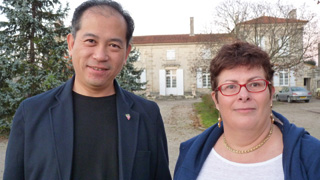 Nelson Chow and Thérèse Ponz
Nelson Chow and Thérèse Ponz The Petit Verdot (3%) produces wines of very steady colour. At good maturity, its tannins are silky and the wine offers very pleasant notes of spices.
For the white wine, two varietals are used: the Sauvignon Blanc, of golden colour, which ensures to extract intense aromas of citrus and yellow fruits and gives to wines a great freshness; and the Sauvignon Gris which works wonders during a maturing in barrels.
Each new vintage is a challenge. Bring the grapes to the winery at the right time is necessary, not too early, neither too early not too late, so frequent tastings and analysis of grapes from different plots are made.
Winemaking is the necessary step to reveal the potential of the harvest. Years pass but not alike … Thierry adapts winemaking techniques to each vintage, combining the use of the old and modern methods. The wine is then subjected to a maturing of 18 months before bottling.
The labelling and capsuling is also made on site. This is the business of Thérèse who got hooked of the game of communication. Her creativity makes her adapt the labels to the country for which the wine is intended, in particular Asia where the Château Berthenon, already well implanted, adorns itself with copper and tin.
Château Berthenon - GFA Ponz
3 le Barrail - 33390 St Paul
Tél. : +33 (0) 5 57 42 52 24
www.chateauberthenon.com Château Cantinot The day ended at Yann and Florence Bouscasse’s
domain by an evening of a relaxed atmosphere, around a wonderful Chinese dinner, nice attention to our Asian guests.
In 2002, after a life dedicated to the maritime world, the family Bouscasse got anchored at Château Cantinot, combining family spirit and team spirit. Yann Bouscasse and his son Tristan are regularly on the roads and in the air to ensure national and international business development of the property. Florence is in charge of the daily management of the Château and the care of his notoriety. After studying for viticulture and oenology, Nicolas, the second son, is responsible for winemaking and maturing. Cellar Master, he is also the vineyard manager.
To further improve the quality of wines, the Chateau has joined forces with Olivier Dauga. This enthusiast is the person that Cantinot needed to reveal year after year its exceptional vintages.
Together, they immediately impose a style and personality to this beautiful property situated not far from the Gironde estuary. Its 18 hectares in one piece offer a subtle blend of gravel, sand, clay and limestone,
of which a parcel of Merlot conceals a vein of the famous “blue clay”, priceless geologic treasure having an invaluable influence on wines.
The varietals: Merlot, Cabernet-Sauvignon and Cabernet-Franc, aged average 25, have a very reasonable planting density of 4,500 feet by hectare. In the vineyard, grass grows naturally, with a light hand weeding in the rows and a regular work of the ground. Particular care is brought to the trellis for a better leafy surface to optimize the grapes’ quality.
An intelligent and controlled manual thinning-out of leaves favours the strengthof the grapes and their future content in sugar. A relevant removing of green bunches of grapes (or green harvest) ensures a perfect yield management and becomes the promise of a concentration of aromas, colour and sugars.
At harvest time, an automatic sorting table is installed, then comes the manual sorting by 4 people. This practice allows having beautiful clean and well-rounded berries for a future cold maceration. Part of the production benefits from fermentation underneath the marc in truncated wood tanks of 30 hl, 50 hl and 70 hl. The maturing is realized from 12 to 24 months with a high proportion of new barrels.

Yann Bouscasse, Nelson Chow and Florence Bouscasse
Thus, from the grape to the bottle, in Blaye Côtes de Bordeaux appellation, the wines of the Château Cantinot become great Bordeaux and especially “Cantinot”, with a unique and much asserted character!
Château Cantinot
1 Cantinot, 33390 Cars
Tél. : +33 (0) 5 57 64 31 70
www.chateau-cantinot.com
Friday, November 25th
This second day of visit, the weather was barely warmer than the day before when we left for Saint-Emilion. The first step was planned at Château La Tour du Pin Figeac and the lunch at Château La Marzelle. In the afternoon, stop at Château Kirwan, in Margaux, then head on Saint-Estèphe for a dinner at Château Clauzet.
Château La Tour du Pin Figeac
Some wisps of fog are still clinging to the vines of the 11 hectares of this domain which benefits from the Saint-Emilion Grand Cru appellation. Formerly attached
to the prestigious property of Figeac, it now belongs
to André Giraud.
His son, Stéphane, welcomes us and tells us how, for 30 years, his father brings special care to the quality of his wines. Moderate yields, careful selection, attentive vinification, and bottling at the Château are the guarantee of production in the respect of tradition.
Adjacent to the prestigious Château Cheval Blanc, the domain is situated in the area of the best crus of the gravels of Saint-Emilion, on the plateau of the Figeac terrace. It benefits from a gravelly and argil-siliceous soil with very ferruginous subsoil allowing the 40-year-old vines to produce the best.
The planted grape varieties are Merlot for 75% and 25% of Cabernet Franc. At perfect maturation, the grape harvest is handpicked by the local staff. Maceration from 3 to 4 weeks is then made to remove a maximum of tannins. Fermentations, long and very controlled, are performed in traditional vats. The aging of wines is made for 2/3 in oak barrels and 1/3 in cement tanks with a rotation of 3 months corresponding to the racking. A blend of vintages is made before bottling. The oenologist Gilles Pauquet follows the winemaking.
The wine of La Tour du Pin Figeac is a full-bodied wine, with bouquet and finesse. Its annual average production is 55 barrels, i.e. approximately 64,000 bottles.
Château La Tour du Pin Figeac
41, rue de Catusseau
33500 Pomerol
Tél. : +33 (0) 5 57 51 06 10
www.vins-giraud-belivier.com 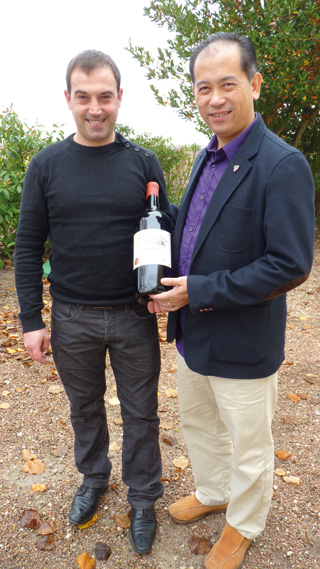
Stéphane Giraud and Nelson Chow
Château La Marzelle
Saint-Emilion Grand Cru Classé, the domain spreads
its 13 hectares of Merlot (80%), Cabernet Franc (13%)
and Cabernet Sauvignon (7%) on a magnificent soil of gravels, sands and clays, just in front of Château Figeac.
In April 1998, Jean-Jacques and Jacqueline Sioen, Belgian textile industrialists, acquired the property. Rebuild a team, renovate vineyards and buildings, restore the image of La Marzelle were their main concerns. Gradually, the host house begins to revive, soil microbial life is reactivated, and growth cycles of the vineyard are experienced with the greatest care. The wines, vinified without any artifice, convey, by their elegance and their subtlety, the most authentic expression.

Philippe Genevey Being Grand Cru Classé implies duties and responsibility of trying to strive for perfection. Philippe explains the philosophy of the house: humility, observation and teamwork. And what a team! Jean-Pierre Desmoulin hold the positions of Head of Culture and Cellar Master; Marc Quertinier, consultant, is the oenologist eye who brings his artistic touch. Sandrine manages reception and administration, and a team of four winemakers completes the staff. A dozen seasonal workers help them from April to July and about fifty pickers are hired for the harvest.
Bart De Winne, based in Belgium, is in charge of the qualitative distribution of Château La Marzelle.
The work of the soil is adapted each year according to climatology. It allows, depending on the chosen operation, in-depth ground aeration, water regulation by favouring its penetration or its ventilation, cutting of superficial roots to force the vine to a deeper rooting. These works prohibit the use of chemical weed killers and thus promote the activation of the soil microbial life necessary for the balance of the plant. Through the quality of its wines, Château La Marzelle observes the first signs of a long-term restructuring of its soils since 1998. In the cellar, the winemaking techniques are adapted each year depending on the typicity of the vintage.
This wealth of work results in true and honest wines, which do not undergo any ‘fashion effect’.
They are elaborated with passion by men who have at heart to obtain the quintessence of their wines and wish to offer to their customers the pleasure of discovering different wines, depending on the vintage.
To close this nice and very informative visit, Philippe Genevey invited us to a fabulous and very convivial lunch at the restaurant of the luxurious Hôtel Grand Barrail, immediate neighbour of the Château La Marzelle.
Installed under the rotunda made of stained-glass dating 19th century, in the dining room whose Moorish Baroque red marble columns, gildings, oriental paintings
in Viollet Leduc style, and old mouldings have been revisited with the concern of preserving their originality and elegance, we enjoyed the wonderful cuisine of Chef Romain Gondras, which perfectly matched the wines of La Marzelle for our greatest pleasure.
Château La Marzelle
33500 Pomerol
Tél. : +33 (0)5 57 55 10 55
www.chateaulamarzelle.com Château Kirwan
The fog having decided to come back and play in the vineyards of the Left bank, we arrived in Margaux later than expected. Philippe Delfaut was waiting for telling us Kirwan. Former technical director of Palmer, he is in charge since 2007 of the general and technique management of the domain, with the advices of renowned oenologists Jacques and Eric Boissenot.
Overlooking the Garonne, the terroir of Château Kirwan marks its peculiarity by dominating the Margaux appellation. The 40 hectares in 46 different plots of the vineyard are situated for two thirds on the beautiful gravelly soil of the plateau of Cantenac surrounding the Château, the rest on the West resting on a more clayey ground.
The average age of vines is 27 years with a planting density of 8,500 stocks per hectare. The Cabernet Sauvignon, king varietal in Medoc that gives structure to the wine and reveals by aging very fine aromas and a wonderful complexity, represents 45% of the grape varieties. Come then the Merlot (30%) which offers fresh, greedy, and intense fruit; the Cabernet Franc (15%) which produces delicate wines with fruity aromas on the argil-calcareous soils; and the Petit Verdot (10%). This varietal is rare in Bordeaux because later and difficult to cultivate but it raises renewed interest in Medoc.
To Kirwan, where it reaches full maturity and participates in the complexity of every blending, it is the subject of special attention.
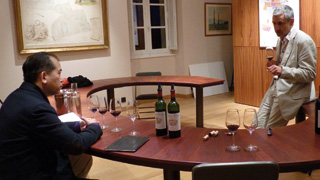 Philippe Delfaut
Philippe Delfaut
In August, the grapes are tasted daily to determine the best time to harvest the plot at complete maturity. A long human chain of permanent and seasonal workers is then set up every morning to pick delicately, sort out carefully the clusters at first, then the berries on arrival at the vat-house. The grapes are put in vats lot by lot, because here it is said that only man can understand the efforts required, so the machines to replace hand-picking are not appropriate.
The wine born in the excitement of the harvest will grow peacefully. The task is wonderful, full of responsibilities and source of experience. Listening, taking the measure of the vintage ensures to adapt the vinification to each lot. The fermentation phase fills the vat-house with a formidable and intense smell. The vatting time lasts about 18 to 25 days, malolactic fermentation included.
If lots are judged since the wine making, only the magic of the blending allows revealing the personality of the cru. From that moment, the wine becomes a unique creation.
The great wine of Château Kirwan takes advantage of about 40% of new wood. Barrel aging lasts 20 months. It is long… but short with regard to decades needed by the wine to improve in bottles.
Château Kirwan perpetuates a tradition of conquest of world markets and enjoys today perfect international legibility,
and singularly towards curious and demanding new consumers who open their mind to the wine universe.
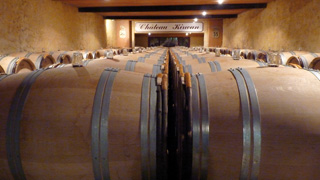
Château Kirwan
33460 CANTENAC
Tél. : +33 (0) 5 57 88 71 00
www.chateau-kirwan.com Château Clauzet
he Château Clauzet adventure started in 1997.
For the Baron Velge, it is the realization of an old dream: “My father had a wonderful cellar, mainly wines of Medoc, and good friends in Bordeaux. The wine's world always attracted me and, when the opportunity to acquire vineyards appeared, I have made the leap!”
Upon his initial acquisition 10 hectares, Maurice Velge adds several parcels chosen according to the most exacting requirements, so constituting a domain classified Cru Bourgeois Supérieur which counts today 30 hectares, among which 27 in production and 3 in plantation, on the best soils of Saint-Estèphe. The main part of the plots acquired by Maurice Velge is situated on this line of hilltops which, from Margaux to Saint-Estèphe, faces the river and is a path of excellence on which sit the finest crus of Medoc.
The gravelly nature of soils is particularly favourable to the growing of vine. The varietals of Château Clauzet are Cabernet-Sauvignon (55%), a significant proportion of Merlot (40%) with a complement of Cabernet Franc (2%) and Petit Verdot (3%). The high age of the whole vineyard—between 30 and 40 years on average—constitutes a major argument in favour of quality. “We try to preserve these old stocks at any cost, they are our greatest asset. They provide a concentrated production and give rich wines. For us, the conservation of the genetic heritage is essential”, specifies José Bueno, manager of the domain. After 23 years spent in the Domains Barons de Rothschild (Mouton Rothschild, d'Armaillacq, Clerc Milon), he has formed the competent and dynamic team that surrounds the Baron Velge. “I know the advanced techniques used in the service of a Premier Grand Cru Classé, he specifies, where even the tiniest details have a major importance. Here, my responsibility extends from vineyard to wine.”
The magnificent heritage of the land ownership ensures, by applying these methods to the vine as well as to the vat-house and the cellar, to produce a wine of very high level, a Grand Vin.

The Baron Maurice Velge
Handpicking is focused on finding a perfect maturity, plot by plot. All the attention concentrates on the quality of the grapes. Yields are controlled to 45 hl/ha. In the vat-house, the choice fell on cement vats of medium-size, as high as wide, to practice the custom-made. The great quality of the harvest allows making good macerations to give the grapes the opportunity to express their full potential.
Maturing is crucial at Château Clauzet, and distinguishes it doubtless from other Châteaux. In order to respect the characteristics of its 35 parcels, the barrels, new for 50%, are selected from 7 to 8 different coopers. In the ageing cellar of first year, barrels are toped up manually 2 or 3 times a week during 5-6 months, to allow the rounding of tannins, the development of aromas, and to favour the wine balance.
The improvement and clarification phase, started naturally, continues in the wine storehouse of second year. This process is done through manual racking performed every three months from barrel to barrel. The fining, made with egg whites, takes place during the second winter, after which—if necessary—the wine can stay a few extra months in barrels. The maturing is practised on fine lees.
Les vendanges manuelles sont axées sur la recherche d'une maturité parfaite, parcelle par parcelle. Toute l’attention se concentre sur la qualité des raisins. Les rendements sont maîtrisés à 45 hl/ha. Au cuvier, le choix s'est porté sur des cuves ciment de taille moyenne, aussi hautes que larges, pour pratiquer du sur-mesure. La grande qualité de la récolte permet de faire de bonnes macérations pour permettre au raisin d'exprimer tout son potentiel.
L’élevage, à Château Clauzet, est capital et le démarque, sans aucun doute, des autres Châteaux. Afin de respecter les caractéristiques de ses 35 parcelles, les barriques, neuves à 50 %, sont sélectionnées auprès de 7 à 8 tonneliers différents. Dans le chai de vieillissement de première année, les fûts sont ouillés manuellement 2 ou 3 fois par semaine pendant 5 à 6 mois pour permettre l’arrondissement des tannins, le développement des arômes et favoriser l’équilibre du vin.
La phase de bonification et de clarification, amorcée naturellement, se poursuit dans le chai de deuxième année. Ce processus est effectué par le biais de soutirages manuels réalisés tous les trois mois environ de barrique à barrique. Le collage, réalisé au blanc d’œuf, a lieu au cours du deuxième hiver, après quoi, si besoin est, le vin peut rester en barriques quelques mois supplémentaires. L’élevage sur lies fines est pratiqué.
Château Clauzet - Château de Côme
Leyssac - 33180 Saint-Estèphe
Tél. : +33 (0)5 56 59 34 16
www.chateauclauzet.com Saturday, November 26th
The day was fully organized within the magnificent Grand Hôtel de Bordeaux & Spa, superb setting for this prestigious event.
In the late afternoon, Philippe Reignier, owner of the Château Fontbonne, where we did not have enough time
to go, came with his daughter to present his wines to Nelson Chow.
A professional tasting of two vintages of each property visited was then attended by Nelson Chow, with the assistance of Bijasson Bertrand, President of the Sommeliers of Bordeaux-Aquitaine. It was perfectly orchestrated by Jean-Michel Thomas, Head Sommelier at the Bordeaux Grand Hotel & Spa, who had prepared the room and put the bottles in condition to be tasted.
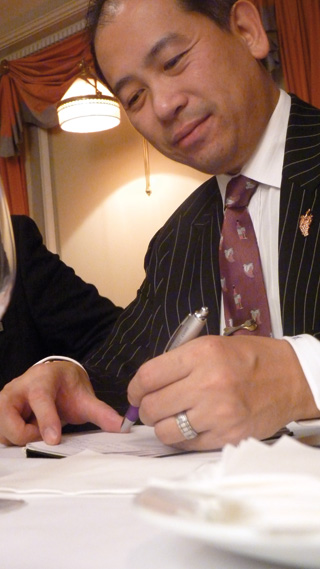
By early evening, when they arrived, somewhat disturbed by traffic problems in the city, around thirty guests were welcomed with a glass of Champagne Gonet Cuvée Prestige 2004.
To honour his guests coming from Hong Kong and thank the domains that had received them, SommelierS International had organized a private dinner in the fabulous lounge Sauternes, historic room in the marble decoration dating from the late 18th century, with frescoed ceilings and magnificent crystal chandeliers, balconies overlooking the Grand Théâtre and the Place de la Comédie.
Bottles opened for the tasting being only two by cuvee, it would have been difficult for the sommeliers of the establishment to provide a classic service at each table. In agreement with Jean-Michel Thomas, and with the aim of creating an informal atmosphere, SommelierS International had deliberately opted to arrange wines on a table where everyone could go and serve.
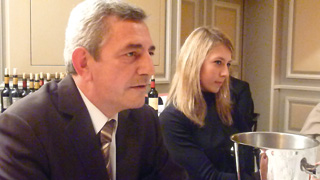 Philippe Renier et sa fille Marie
Philippe Renier et sa fille Marie Innovative decision but winning bet for the guests who, although somewhat surprised at first, have quickly enjoyed to make taste their wines and savour those of their neighbours.
The dinner was lively and relaxed, and the great talent of the Chef Pascal Nibaudeau offered to their palate a magnificent journey in the incredible richness of aromas and flavours. The ‘Lobster roasted in hot pepper and curry butter with light and crisp Fennel, Chanterelles, Ginger, and Citrus’ was followed by a ‘Duck Breast and Foie gras, St. Germain Peas, Mushrooms, Tandoori flavour, Bacon, and Red pepper Coulis’. The ‘Roasted Goat’s cheese and its apricots and rosemary Chutney’ preceded a surprising dessert called ‘Rose’, namely a hazelnut Dacquoise, Pink lychee ganache, Green tea granita, Hibiscus sorbet, and sesame biscuit’… A wonder of delicacy!
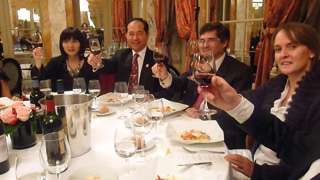
Liste des convives par tablée :
Table d'honneur : Nelson et Angelle CHOW
Florence DUBOURDIEU (Château Reynon)
Henri LURTON (Château Brane-Cantenac)
Nathalie SCHYLER (Château Kirwan)
Aline et Frédéric GONET (Château Lesparre)
Antoine Michel (Château Faugères)
Isabelle et Eric ALLOUCHE
Table 2 : Dominique Peyral-Bon
Philippe DELFAUT (Château Kirwan)
Jean-Marc Koch
Eric FORGET (Thomas Hine)
Sandy BENARD
Denis DARRIET et Catherine JOLLY (Château Seguin)
Table 3 : Florence Varaine
Sylvia VAN DER VELDEN
Per Even ALLAIRE (Thomas Hine)
Marie et Philippe RENIER (Château Fontbonne)
Florence et Yann BOUSCASSE (Château Cantinot)
Table 4 : Thérèse PONZ Szymanski et Henri PONZ
(Château Berthenon)
Jean-Christophe OLLIVIER et Madame
Bertrand Bijasson
Michel AKRICH
Aris ALLOUCHE
Grand Hôtel de Bordeaux & Spa
2 Place de la Comédie - 33000 Bordeaux
Tél. : +33 (0)5 57 30 44 44
www.ghbordeaux.com
Monday, November 28th
This day was completely devoted to the discovery of another gustative treasure of the southwest France: Armagnac. So we left for Nogaro, small village of the Gers in the heart of Gascony. The Bas-Armagnac is the region of the crus the most renowned for their finesse, where the Maison Dartigalongue was expecting us.
Bas-Armagnac Dartigalongue
The Maison Dartigalongue has been founded in 1838. It still belongs to the more and more restricted circle of family Houses of producers traders of Bas-Armagnac. Françoise Dartigalongue manages the property, worthy heiress of a 5 generations lineage. With Ghislain Laffargue, Cellar Master for over 20 years, she cultivates the image of this House in the utmost respect for traditions. Together, they perform with extreme precision the necessary blending to obtain delicacy, roundness and homogeneity in the time.
In a period when consumers demand shifts toward ever-
younger wines, the Maison Dartigalongue goes against the grain.
It devotes its time to the elaboration of very high quality products, which, over the years, slowly reach their maximum level of maturity and refinement. Here, brandies are matured to transmit greatest delight to lovers of ageing and Armagnac with strong tradition.
Benoit Hillion, in charge of national and international business development, joined the team for a little more than a year. He has sought to maintain and expand its core markets but also to make new contacts in China.
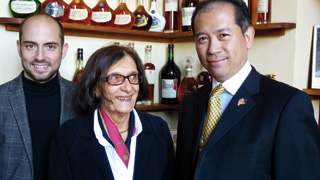
Benoît Hillion, Françoise Dartigalongue et Nelson Chow
His Armagnac triumphed twice in Hong-Kong: first at a prestige dinner gathering numerous professionals of the sector under Nelson Chow’s presidency, then in April 2011, during the Contest of the best French wines and Spirits in Asia where the Bas–Armagnac Dartigalongue 1989 received the highest reward of the competition: the Platinum Medal.
It is thus in hopes of better understanding and penetrating the Chinese market that Françoise Dartigalongue and Benoit Hillion received us in their installations of Nogaro. Upon our arrival, Nelson Chow made a brief presentation of what are the sales of Armagnac in Hong-Kong and in China in financial and quantitative terms. Benoît Hillion showed prototypes of bottles and labels on which he works to have Nelson Chow’s valuable advice in the style to adopt in order to satisfy Asian buyers.
We visited the wine storehouses where the stills and demi-johns of the oldest vintages are resting, then the shipping room, and finally the ageing cellars sheltering Armagnacs among which some are more than a century old. With humour, Nelson Chow autographed a barrel containing a vintage of his year of birth. The beauty of the place and the omnipresent tradition prepared us for the tasting that followed. And what a tasting: a remarkable vertical composed of rare vintages!
Nelson Chow was thus able to verify the precision, elegance and harmony of these spectacular Armagnacs:
- Eau-de-vie Blanche vintage 2011 - 58° exit of still
- VSOP - 40°
- XO - 40°
- 1994 - 40°
- 15 years - 40°
- 1991 - 46° (range Sélection de Millésimes, numbered bottles)
- 1989 - 45° (range Sélection de Millésimes)
- 1989 - 40°
- 1986 - 48° (range Sélection de Millésimes)
- 25 years old - 40°
- 1979 - 40°
- 1976 - 45° (range Sélection de Millésimes)
- 30 years old - 40°
- Cuvée Louis-Philippe - 42° (composition: 70% of 1974, 30% of 1976)
- 1963 - 40°
- 1959 - 40°
- 1934 - 40°
- 1893 - 40°
This magnificent tasting of the jewels of the Maison Dartigalongue seduced us by the overall quality of the range, but also by the length, balance, unctuousness, and impressive aromatic range of these Armagnacs, especially on Nelson Chow’s favourites: XO, 15 years, 1991, 1989, 1976, 30 years, 1934 and 1893.
Françoise Dartigalongue gave us her best advice:
“Although Armagnac is still considered as a liqueur, the best moment to enjoy it is morning, when the palate has not yet been approached”.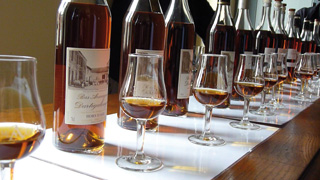
She taught us that to make a drink with Armagnac, one must choose 5 years old and mix with orange juice and/or ice to savour it. Armagnacs of 25 years, generally more fruity, seduce especially women. Male audience prefers those that exceed 30 years and offer more toasted, smoked, spicy notes and can even remind some cigars. This brandy shows very slowly its ever-changing palette of aromas. Its natural evolution in the glass makes its tasting very interesting.
After a lunch break, we had another privilege: that of discovering the personal museum of the Dartigalongue family where one can find posters, registers, letters, postcard, manuscript, material dating more than 150 years. The visit ended in the ‘Paradis’, where lie the oldest vintages of Armagnac Dartigalongue, the most ancient dating from 1823!!! A feast for the eyes but also a journey through time, all these bottles bearing witness to the times they went through.
Armagnac Dartigalongue & Fils
Place du Four
32110 NOGARO
Tél. : +33 (0)5 62 09 03 01
www.dartigalongue.com
Tuesday, November 29th
Located on the sunny hillsides of the Dordogne valley, six kilometres east of Saint-Emilion, the domain has long been led by Pierre-Bernard and Corinne Guisez. Through their involvement in the vineyards and many innovations, Château Faugères quickly became, with the help of Michel Rolland, a landmark of the appellation. Upon the death of her husband, in 1997, Corinne continues to work with her daughters, bringing some of the best wine of Saint-Emilion.
Château Faugères
Family circumstances finally drive her to sell the estate in March 2005 to a Swiss entrepreneur, Silvio Denz, perfume designer, lover of fine wines, owner of Lalique and of two wine merchants in Zurich, as well as Switzerland’s largest wine auctioneers “Les grands Vins Wermuth S.A.”. His portfolio also includes Château de Chambrun in AOC Lalande de Pomerol and Montepeloso in Tuscany, and he is associated with the Clos d’Agon vineyard in Catalonia.
Silvio Denz entrusts the construction of a new wine storehouse to his compatriot Mario Botta, “Master of Light and Gravity”, who has succeeded in turning the Château Faugères winery into a masterly work of art - a veritable cathedral of wine. “I imagined a partially buried stone base, with space needed for production as well as for storage barrels for ageing. One prominent architectural element stands in the centre of the building: a tower for public reception and tasting activities, with on the top a vast covered terrace opening onto the landscape”.
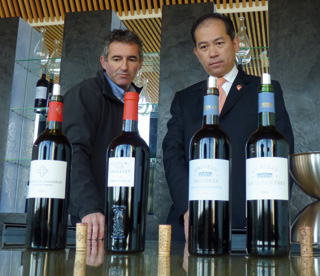 Alain Dourthe et Nelson Chow
Alain Dourthe et Nelson Chow
The domain produces several wines classed Saint-Emilion Grand Cru : the original growth, Château Faugères, 85 % Merlot, 10% Cabernet Franc and 5% Cabernet Sauvignon; the second wine Haut Faugères; and Péby Faugères which became in 2005 Château Faugères Cuvée spéciale Péby, a single-varietal 100% Merlot.
On the 37 hectares of limestone and clayey limestone exceptional soils of Château Faugères, the average age of the vines is 35 years, planting density of 6,000 stocks per hectare. ‘Guyot double’ pruning, plowing and inter-row grassing, debudding, leaf-stripping and thinning by hand are meticulous care throughout the vegetation cycle that ensure optimal ripening of the grapes until the harvest made manually in small crates.
For Silvio Denz, the purpose of the new winery is to serve the never-ending quest to improve the quality of the wine at every stage of production, deploying the very latest technology, with absolute priority given to the capacity, the layout and the optimization of internal procedures. We enter through the ground floor where is situated the harvests reception … and the top of tanks. The architect indeed made best use of the gradient of the slope to build a gravitational wine storehouse.
Before being put into vats, the grapes stay in a cold room so that fermentation does not start immediately. Once at 8°, they are de-stemmed and passed through an optical sorter to fall into a metal vat which is then emptied into the tank without pumping. The maceration at low temperature lasts 3 days before the start of the alcoholic fermentation is decided.
The 40 tanks from 60 to 80 hl made of French oak are thermo regulated. To extract colours and tannins, punching of the cap and pumping over are alternate. Once completed the alcoholic fermentation, the wine is flowed barrels by gravity to make its ‘malolactic’. The marc is pressed with vertical presses of the latest generation. The barrels are placed on Oxoline supports that allow stacking them while being able to return them or get them out of the pile without moving any other.
Alain Dourthe, manager of the domain, commented for us this fascinating visit and answered our numerous questions, before leading us at the top of the tower. In this beautiful tasting space opened on the vineyard, where sobriety of the lines and selected materials compete in elegance and serenity, we will taste the treasures of the Château before sharing a delicious lunch.
Château Faugères
33330 Saint-Etienne de Lisse
Tél. : +33 (0)5 57 40 34 99
www.chateau-faugeres.com
Château Brane-Cantenac
Under the sun but in the cold, we took the road of the Estuary and admired unreservedly the landscapes of the Left Bank vineyards that the fog had hidden the four precedent days.
The prestigious history of Brane-Cantenac is not linked to a personality or a family but to the estate’s incomparable soil. Recognised throughout the estate’s history as one of the finest in the Medoc, Brane’s terroir long gave the estate its unofficial ranking as ‘first of the seconds’.
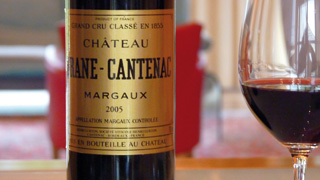
Château Brane-Cantenac has built its legend around a vineyard of 80 hectare comprised of different plots. The biggest of them with its 30 hectares lies right in front of the château, on the finest bench of large-sized gravel in the appellation: the plateau of Brane. With about 15 hectares situated behind the park, it constitutes the heart of the property. It is on this 45 hectare unbroken block which remained unchanged for three centuries, that Henri Lurton chose to centre the First Wine of Brane-Cantenac, Second Grand Cru Classé in 1855.
The Lurton family has continued the dialogue with the domain over the past four generations. Henri Lurton succeeds his father, Lucien, in 1992.
He has made it his aim to produce each year the best wine possible while remaining faithful to the outstanding historic terroir of Brane. Since 1997, a new, spacious vat cellar, modern wine-making techniques and a new team have enabled him to rise to this challenge.
We are welcome by Maria Martinez Ojeda and Christophe
Capdeville, Estate manager since 2004. Maria holds the post of Quality Control manager, monitoring the quality of tasks performed in the vineyard and cellar, and looks after the preparation of wine samples. She is also in charge of welcoming visitors. Christophe has just celebrated his twentieth year at Brane. At first Cellar master, then Technical director, he became naturally Henri’s right hand man. He explains to us in detail, how Henri Lurton chose last summer to make substantial changes in the harvest reception area in order to be sure of bringing in grapes of absolutely perfect quality.
The grapes are now brought to the cellar using the Air Tec Wine device, which avoids any squashing of the grapes. The device is made up of small, shallow bins equipped with automatically-controlled compressed air pneumatic suspension. These bins are fit with wide low-inflated tyres. The grapes are emptied from the bins at slow speed using
a system of vibration. The advantages of using this device are that the berries remain perfectly intact and any oxidation is limited through fast handling of the grapes within half an hour of picking.
When they arrive at the cellar the grapes are manually sorted on two parallel tables. Once they have passed through the de-stemmer they come to the newly-installed Vistalys optical sorting line.
All of the constituents resulting from the de-stemming are filmed by a camera. A high-speed calculator analyses the pictures. Air jets then specifically eliminate any imperfections.
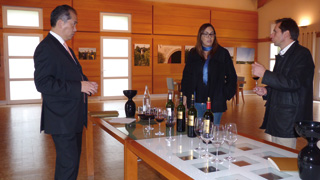 Nelson Chow, Maria Martinez Ojeda
Nelson Chow, Maria Martinez Ojeda
et Christophe Capdeville It is therefore possible to sort not only according to colour (fragments of stems, shot berries and so on) but also by berry-shape (withered or rotten grapes and so on). This revolutionary process enables an unprecedented level of sorting quality. It is reliable, fast, consistent and progressive.
On occasions he is a pioneer; on others he may oppose the latest winemaking fashion. He loves conducting experiments both in the vineyard and in the cellars. Always better to know the soil, enhance the specificity of a parcel, raise a great Margaux racy, aromatic, complex and balanced on a deep gravely soil or innovate with modern farming techniques are among the achievements that rhythm his daily life.
He has a love of land and vines. His greatest passion is creating an outstanding wine, year after year, seeking the perfect symbiosis
between man and nature, which alone is capable of expressing the quintessence of the terroir.
Château Brane-Cantenac
33460 Margaux
Tél. : +33 (0)5 57 88 83 33
www.brane-cantenac.com Thomas Hine
The final step of our gourmet trip was planned in the Cognac region. The distance by road being important, we preferred to adopt the local customs by taking the ferry, a real institution in the Estuary which allowed us to attach one side to the other in 30 minutes. In landing at Blaye, it remained for us to reach the Hine House on the banks of the Charente, where Eric Forget, the Cellar Master, was going to tell us the story of its Cognacs.
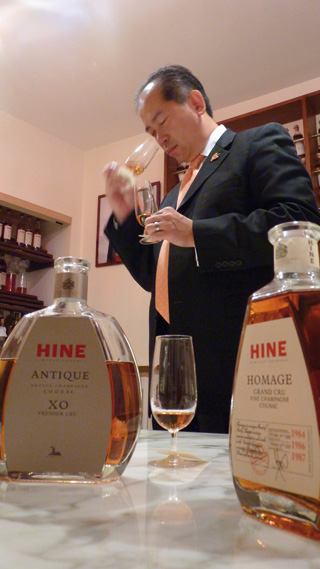
The Maison Hine is one of the oldest houses in Jarnac, deep in Cognac country. From nearby docks once began the journey of its Cognacs in the world. The experimental English designer Russell Sage, known for his love of antique textiles, ancient buildings and the finer things in life, was brought in to give the place fresh new appeal. He combined the ‘best of British' with out-and-out British eccentricity. His unorthodox approach — much in line with Hine's — gave rise to a delightfully original interior design style.
The extraordinary saga of Hine family has lasted for six generations and begun during the 18th century in Beaminster, Dorset. Thomas Hine, the father — quite a Cognac connoisseur — decided to send his son Thomas (one of eleven children) to France to learn French and the art of making Cognac. The young man, then aged sixteen, began his employment as a personal assistant for the négociant who creates his father's favourite Cognac... and falls in love with Elisabeth, the merchant’s daughter. He will marry her six years later. When his father-in-law died, his mother-in-law chose Thomas—rather than one of her sons—to take charge of the family cognac business. In 1817, he gave its definitive name to the company: Thomas Hine & Co.
Bernard Thomas Hine is the current Hine family member. His renowned
Cognac creations include Rare, Mariage and Talent. In the 1960's, he adds Germany, central Europe and Asia to the long, growing list of Hine markets, and seduces Russia in 2000’s. In keeping with the Hine values, he has pursued his passion for single vintage
cognacs — which are officially recognised — thus upholding
and furthering the great family tradition.
Ugni Blanc — also called Saint-Emilion des Charentes — is the main grape variety permitted in the production of the wine for cognac. The Maison Hine uses grapes harvested only in Grande Cham-
pagne and Petite Champagnes, the two best crus of the region.
The grapes are picked and put into a pneumatic press which gently extracts the juice. The grape juice is then transferred into vats for fermentation — a natural process lasting approximately one week. The translucent wine is fruity, dry and lightly acidic. It is relatively low in alcohol, around 9% by volume and is now ready to be distilled.
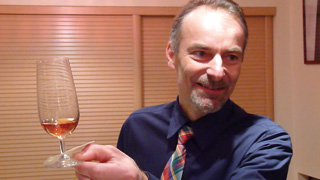
Eric Forget
The Hine distillers carry out a careful micro-distillation of only the best wines that are selected for distillation. This process enables them to identify any defect which could be detected by tasting and therefore eliminate the wines which are not of the highest quality. The distillation of Cognac is carried out in two stages over a naked flame, following a tradition which dates back to the 16th century.
To ensure the constancy of Hine's classic cognacs, Eric Forget carefully selects and blends Cognacs of different age and crus. Once he has decided on the exact proportions he needs, the cognacs are blended in large oak vats. They are then returned to casks where they are aged for a further six to nine months until the perfect “marriage” has been achieved.
In an exceptional year, the Cellar Master may decide to set aside a few casks of Grande Champagne cognacs to be aged separately. If the weather has been fair throughout the growing season, it is likely — but by no means sure — that the resulting Cognacs will become single vintages. These Cognacs are exceptions, and are not subject to blending. From the beginning, Hine, House known for its reliability, was used to vintage a few Cognacs, Grande Champagne exclusively, of exceptional quality. From this time also, Hine ships some of those single vintage cognacs to London and Bristol, two cities that have a reputation for aging the wines. These are known as Early Landed cognacs. Nowadays
 Graduate of the University of South Australia, Nelson Chow has over 30 years of management experience in the hospitality industry as well as extensive teaching experience in hotel management and wine appreciation. His expertise has won him a number of highly respected titles in the professional realm, such as Chevalier de la Gastronomie Française and Commandeur du Bontemps. He is an accredited lecturer for the Ecole du Vin de Bordeaux (CIVB*).
Graduate of the University of South Australia, Nelson Chow has over 30 years of management experience in the hospitality industry as well as extensive teaching experience in hotel management and wine appreciation. His expertise has won him a number of highly respected titles in the professional realm, such as Chevalier de la Gastronomie Française and Commandeur du Bontemps. He is an accredited lecturer for the Ecole du Vin de Bordeaux (CIVB*).














 Alain Dourthe et Nelson Chow
Alain Dourthe et Nelson Chow


